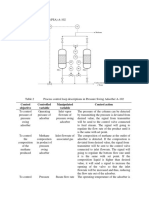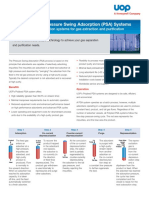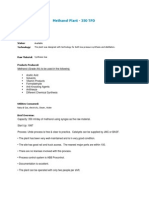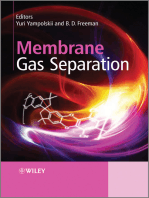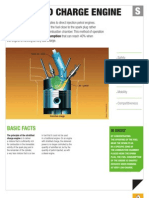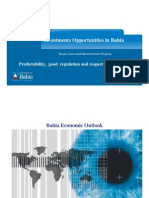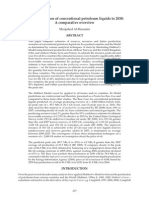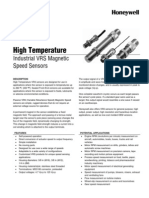Linde PSAs
Linde PSAs
Uploaded by
Siji AntonyCopyright:
Available Formats
Linde PSAs
Linde PSAs
Uploaded by
Siji AntonyOriginal Description:
Copyright
Available Formats
Share this document
Did you find this document useful?
Is this content inappropriate?
Copyright:
Available Formats
Linde PSAs
Linde PSAs
Uploaded by
Siji AntonyCopyright:
Available Formats
Hydrogen Recovery
by Pressure
Swing Adsorption
Contents.
3 Introduction
4 The process
5 The PSA sequence
6 Scope of supply
7 The advantages
8 Contact
Introduction.
The experience.
The use of the Pressure Swing Adsorption (PSA) process
has seen tremendous growth during the last decades
mainly due to its simplicity and low operating costs.
Major applications have been the recovery of high purity
hydrogen, methane and carbon dioxide as well as the
generation of nitrogen and oxygen. In addition, it has
gained significance for the bulk removal of carbon
dioxide from direct reduction top-gases.
Linde as the world leader in adsorption technology
has designed and supplied more than 500 PSA plants
including the worlds largest units and units with
highest availability.
The Linde hydrogen PSA units
The well proven Linde High Performance Pressure Swing Adsorption (PSA) units are designed
for the recovery and purification of pure hydrogen from different hydrogen - rich streams, such
as synthesis gases from steam reforming or gasification processes, or from various off-gases in
refinery or petrochemical plants.
Capacities range from a few hundred Nm/h to
large scale plants with more than 400,000 Nm/h.
The hydrogen product meets every purity require-
ment up to 99.9999 mol-% and is achieved at
highest recovery rates.
Main hydrogen consumers are refineries requiring this valuable gas for example for their hydrocracking, dearomatization or desulphurization
processes.
As a second group of users the petrochemical
industry has a considerable demand for hydrogen for its processes (e.g. methanol and ammo-
nia synthesis). Additionally, Linde provides PSA
solutions to a variety of other consumers like the
electronics, biomass, and steel industries.
Lindes PSA systems have proven to be successful in cases where performance, flexibility, availability and reliability are the determining factors.
High quality and easy accessibility to all components minimize and facilitate maintenance to the
maximum extent.
The process.
Separation by adsorption
The Pressure Swing Adsorption (PSA) technology
is based on a physical binding of gas molecules
to adsorbent material. The respective force acting between the gas molecules and the adsorbent material depends on the gas component,
type of adsorbent material, partial pressure of
the gas component and operating temperature.
A qualitative ranking of the adsorption forces is
shown in the figure below.
The separation effect is based on differences in
binding forces to the adsorbent material. Highly
volatile components with low polarity, such as
hydrogen, are practically non-adsorbable as
opposed to molecules like N2, CO, CO2, hydrocarbons and water vapour. Consequently, these
impurities can be adsorbed from a hydrogencontaining stream and high purity hydrogen is
recovered.
Adsorption and regeneration
The PSA process works at basically constant
temperature and uses the effect of alternating
pressure and partial pressure to perform adsorption and desorption. Since heating or cooling is
not required, short cycles within the range of
minutes are achieved. The PSA process consequently allows the economical removal of large
amounts of impurities.
The figure on page 5 illustrates the pressure
swing adsorption process. It shows the adsorption isotherms describing the relation between
partial pressure of a component and its equilibrium loading on the adsorbent material for a
given temperature.
After termination of regeneration, pressure is
increased back to adsorption pressure level and
the process starts again from the beginning.
Pressure swing adsorption plant in Leuna, Germany
Qualitative ranking of adsorption forces
Hydrogen
weak
Oxygen
Argon
Nitrogen
Carbon monoxide
Methane
Carbon dioxide
Ethane
Ethylene
Propane
Butane
Propylene
Ammonia
Hydrogen sulfide
Mercaptanes
BTX
Water
Adsorption is carried out at high pressure (and
hence high respective partial pressure) typically
in the range of 10 to 40 bar until the equilibrium
loading is reached. At this point in time, no
further adsorption capacity is available and the
adsorbent material must be regenerated. This
regeneration is done by lowering the pressure
to slightly above atmospheric pressure resulting
in a respective decrease in equilibrium loading.
As a result, the impurities on the adsorbent
material are desorbed and the adsorbent material
is regenerated. The amount of impurities removed from a gas stream within one cycle
corresponds to the difference of adsorption to
desorption loading.
strong
Adsorption isotherms
Adsorption loading
Differential loading
0C
30C
50C
Desorption loading
200C
PD
Desorption pressure
Partial pressure
PA
Adsorption pressure
Adsorption and regeneration by pressure swing
The PSA sequence.
A PSA plant consists basically of the adsorber
vessels containing the adsorbent material, tail
gas drum(s), valve skid(s) with interconnecting
piping, control valves and instrumentation as
well as a control system for control of the unit.
The pressure swing adsorption process has four
basic process steps:
Adsorption
Depressurization
Regeneration
Repressurization
To provide continuous hydrogen supply, minimum 4 adsorber vessels are required. The figure
on page 6 shows the combination of the sequences of four adsorber vessels as a pressure-timediagram.
Adsorption
Adsorption of impurities is carried out at high
pressure being determined by the pressure of
the feed gas. The feed gas flows through the
adsorber vessels in an upward direction. Impurities such as water, heavy hydrocarbons, light
hydrocarbons, CO2, CO and nitrogen are selectively adsorbed on the surface of the adsorbent
material. Highly pure hydrogen exits the adsorber vessel at the top. After a defined time, the
adsorption phase of this vessel stops and regeneration starts. Another adsorber takes over the
task of adsorption to ensure continuous hydrogen supply.
total number of adsorbers and the process conditions, one to four of these so-called pressure
equalization steps are performed. Each additional pressure equalization step minimizes
hydrogen losses and increases the hydrogen
recovery rate.
Regeneration
The regeneration phase consists of basically
five consecutive steps:
Pressure equalization
Provide purge
Dump
Purging
Repressurization
Provide purge (step PP)
This is the final depressurization step in co-
current direction providing pure hydrogen to
purge or regenerate another adsorber.
The steps are combined so as to minimize hydrogen losses and consequently to maximize the
hydrogen recovery rate of the PSA system.
Pressure equalization (step E1)
Depressurization starts in the co-current direction from bottom to top. The hydrogen still stored
in the void space of the adsorbent material is
used to pressurize another adsorber having just
terminated its regeneration. Depending on the
Dump (step D)
At a certain point of time, the remaining pressure must be released in counter-current direction to prevent break-through of impurities at
the top of the adsorber. This is the first step of
the regeneration phase when desorbed impurities leave the adsorber at the bottom and flow
to the tail gas system of the PSA plant.
Scope of supply.
Purging (regeneration)
Final desorption and regeneration is performed
at the lowest pressure of the PSA sequence.
Highly pure hydrogen obtained from an adsorber
in the provide purge step, is used to purge the
desorbed impurities into the tail gas system.
The residual loading on the adsorbent material is
reduced to a minimum to achieve high efficiency
of the PSA cycle.
Pressure
Repressurization (steps R1/R0)
Before restarting adsorption, the regenerated
adsorber must be pressurized again. This is
accomplished in the pressure equalization step
by using pure hydrogen from adsorbers presently
under depressurization. Since final adsorption
pressure cannot be reached with pressure
equalization steps, repressurization to adsorption pressure is carried out with a split stream
from the hydrogen product line.
Having reached the required pressure level
again, this regenerated adsorber takes over the
task of adsorption from another vessel having
just terminated its adsorption phase.
The typical scope of supply of Lindes PSA
units includes:
Prefabricated valve skid
Adsorber vessels
Specially selected adsorbent material
Tail gas drum
Process control system
The scope can be altered to best suit clients
needs. Based on the customers requirements,
feed gas compressor or tail gas compressor
systems can be offered through Linde as an
integrated PSA solution.
PSA valve skid
Pressure time diagram
Adsorber A
Adsorption
E1
R0
PP
R1
D
Regeneration
Adsorber B
Adsorption
R0
E1
R1
PP
D
Regeneration
Adsorber C
Adsorption
R0
E1
D
Regeneration
PP
R1
Adsorber D
R0
Adsorption
E1
PP
Regeneration
R1
Time
Two pressure swing adsorption units in Canada
The advantages.
The Linde High Performance PSA units provide
remarkable advantages such as:
Lindes 30 years of expertise in adsorption
technology
Based on specific customer requirements, Linde
specialists select the optimal PSA system for distinct purification tasks in order to achieve a perfect balance between plant performance and
investment costs.
Quality and reliability
PSA process requirements make an informed
selection of specially proven plant components
(e.g. switching valves and related instrumentation) necessary. Linde only uses suitable and
thoroughly selected, tested and approved plant
components. This guarantees highest reliability
of Lindes PSA systems.
Outstanding availability
Linde PSA systems are characterized by an outstanding availability of hydrogen supply. With its
special features such as operation with reduced
number of adsorbers, adsorber group isolation
and redundant control system, Linde PSA systems
achieve virtually 100% on-stream performance
and availability.
Excellent flexibility
Linde PSA systems achieve excellent flexibility
in coping with varying feed gas conditions and
hydrogen demands to match individual client
needs.
Modular design and prefabricated equipment
Linde High Performance PSA systems are prefabricated to the maximum extent. The valve skid
containing switching and control valves, instrumentation and interconnecting piping is completely prefabricated, preassembled and tested
prior to delivery. This design philosophy reduces
time and costs for erection and commissioning
on site to the absolute minimum.
Easy maintenance
Maintenance necessity is limited to routine actions, which can be carried out by the operators
on site. Linde pays highest attention to proper
accessibility of all valves and instruments inside
the valve skid. Hence, maintenance assistance
from Linde is normally not required, but is certainly available at any time.
Designing processes constructing plants.
Lindes Engineering Division continuously develops extensive process engineering know-how in the planning,
project management and construction of turnkey industrial plants.
The range of products comprises:
Petrochemical plants
LNG and natural gas processing plants
Synthesis gas plants
Hydrogen plants
Gas processing plants
Adsorption plants
Air separation plants
Cryogenic plants
Biotechnology plants
Furnaces for petrochemical plants and refineries
The Engineering Division
and its subsidiaries manufacture:
Packaged units, cold boxes
Coil-wound heat exchangers
Plate-fin heat exchangers
Cryogenic standard tanks
Air heated vaporizers
Spiral-welded aluminium pipes
More than 4,000 plants worldwide document the leading position of the Engineering Division in international
plant construction.
Linde Engineering Dresden GmbH
Dresden, Germany
Phone +49.351.250-30
Fax
+49.351.250-4800
ledd.dresden@linde-le.com
SELAS-LINDE GmbH
Pullach, Germany
Phone +49.89.7447-470
Fax
+49.89.7447-4717
selas-linde@linde-le.com
Cryostar SAS
Hsingue, France
Phone +33.389.70-2727
Fax
+33.389.70-2777
info@cryostar.com
Linde CryoPlants Ltd.
Aldershot, Great Britain
Phone +44.1.252.3313-51
Fax
+44.1.252.3430-62
info@linde-lcl.com
Linde Impianti Italia S.p.A.
Rome, Italy
Phone +39.066.5613-1
Fax
+39.066.5613-200
m.margheri@lindeimpianti.it
Selas Fluid Processing Corp.
Blue Bell, PA, U.S.A.
Phone +1.610.834-0300
Fax
+1.610.834-0473
sales@selasfluid.com
Linde Arabian Contracting Co. Ltd.
Al-Khobar, Kingdom of Saudi Arabia
Phone +966.3.887-1191
Fax
+966.3.887-0133
klaus.libal@linde-le.com
Linde Engineering Co. Ltd.
Dalian, P.R. of China
Phone +86.411.3953-8819
Fax
+86.411.3953-8899
info@lindeLED.com
Linde Kryotechnik AG
Pfungen, Switzerland
Phone +41.52.3040-555
Fax
+41.52.3040-550
info@linde-kryotechnik.ch
Linde Engenharia do Brasil Ltda.
So Paulo, Brazil
Phone +55.21.3545-2255
Fax
+55.21.3545-2257
jaime.basurto@linde.com
Linde Engineering Middle East LLC
Abu Dhabi, United Arab Emirates
Phone +971.2.6981-400
Fax
+971.2.6981-499
leme@linde.com
Linde Engineering Co. Ltd.
Hangzhou, P.R. of China
Phone +86.571.8501-9222
Fax
+86.571.8501-9200
info@lindeLEH.com
Bertrams Heatec AG
Pratteln, Switzerland
Phone +41.61.467-7525
Fax
+41.61.467-7500
hubertus.winkler@linde-le.com
Linde Process Plants (Pty.) Ltd.
Johannesburg, South Africa
Phone +27.11.490-0513
Fax
+27.11.490-0412
linde.za@linde-le.com
Linde Engineering India Pvt. Ltd.
Vadodara, Gujarat, India
Phone +91.265.3056-789
Fax
+91.265.2461-757
sales@linde-le.com
Linde Engineering Division
Beijing Representative Office
Beijing, P.R. of China
Phone +86.10.6437-7014
Fax
+86.10.6437-6718
info@linde-lecn.com
CRYO AB
Gothenburg, Sweden
Phone +46.3164-6800
Fax
+46.3164-2220
lars.persson@cryo.aga.com
Linde Engineering Dresden GmbH
Moscow Office, Russia
Phone +7.495.6426-242
ledd.moscow@linde-le.com
Linde Engineering Far East, Ltd.
Seoul, South Korea
Phone +82.2789-6697
Fax
+82.2789-6698
hanyong.lee@linde.com
Linde Process Plants, Inc.
Tulsa, OK, U.S.A.
Phone +1.918.4771-200
Fax
+1.918.4771-100
sales@lppusa.com
Linde Arabian Contracting Co. Ltd.
Riyadh, Kingdom of Saudi Arabia
Phone +966.1.419-1193
Fax
+966.1.419-1384
jochen.nippel@linde-le.com
Linde Engineering Taiwan Ltd.
Taipei, Taiwan
Phone +886.2.2786-3131
Fax
+886.2.2652-5871
tso.ming.hsieh@linde-le.com
Linde Engineering Division
Bangkok, Thailand
Phone +66.2751-9200
Fax
+66.2751-9201
anuwat.krongkrachang@linde.com
Linde AG
Engineering Division, Head office, Dr.-Carl-von-Linde-Strasse 6-14, 82049 Pullach, Germany
Phone +49.89.7445-0, Fax +49.89.7445-4908, E-Mail: info@linde-le.com, www.linde-engineering.com
HA/H/1.1.e/12
Engineering Division
Schalchen Plant
Tacherting, Germany
Phone +49.8621.85-0
Fax
+49.8621.85-6620
plantcomponents@linde-le.com
You might also like
- Introduction To Wellbore Clean Up E-BookDocument14 pagesIntroduction To Wellbore Clean Up E-BookSudish Bhat100% (6)
- Pressure Swing AdsorptionDocument2 pagesPressure Swing AdsorptionaiensyafiqahNo ratings yet
- Internship ReportDocument23 pagesInternship Reportswikriti mittal50% (2)
- The Worlds Top 100 Non Financial MNEs Ranked by Foreign Assets 2018Document8 pagesThe Worlds Top 100 Non Financial MNEs Ranked by Foreign Assets 2018Penguin_MaestroNo ratings yet
- UOP Optimized Mercury Removal in Gas Plants Tech PaperDocument18 pagesUOP Optimized Mercury Removal in Gas Plants Tech PaperPherx JhossNo ratings yet
- Lurgi Mega Methanol by Combined ReformingDocument25 pagesLurgi Mega Methanol by Combined ReformingKeena Rahim100% (1)
- Sulphur Recovery UnitDocument39 pagesSulphur Recovery UnitChetal Bhole100% (1)
- Boldrocchi Company Presentation 2013pdfDocument45 pagesBoldrocchi Company Presentation 2013pdfKenny RuizNo ratings yet
- BHS RPMDocument16 pagesBHS RPMchand_yelNo ratings yet
- Polybed PSADocument2 pagesPolybed PSAJeEJyZaNo ratings yet
- Uop Polybed Psa For Gas Extraction Purification DatasheetDocument2 pagesUop Polybed Psa For Gas Extraction Purification DatasheetRaji RauofNo ratings yet
- Atmospheric CO2 To MethanolDocument16 pagesAtmospheric CO2 To MethanolMUTHU KESHAV KNo ratings yet
- Uop Polybed Psa Overview BrochureDocument2 pagesUop Polybed Psa Overview BrochureVibianti Dwi PratiwiNo ratings yet
- CO2 Removal AminesDocument18 pagesCO2 Removal AminesHamzaHashimNo ratings yet
- MESSER Gase For Life On-Site - Gas - Production PDFDocument12 pagesMESSER Gase For Life On-Site - Gas - Production PDFnefoussiNo ratings yet
- Acid Gas TreatmentDocument10 pagesAcid Gas TreatmentasdasdasdasdasdasdasdNo ratings yet
- 04 - Maximize Benefit From Your PRIME-G+ Proceedings PDFDocument40 pages04 - Maximize Benefit From Your PRIME-G+ Proceedings PDFmujeebtalibNo ratings yet
- Uop Benfield DatasheetDocument2 pagesUop Benfield DatasheetSusan Monteza GrandezNo ratings yet
- Chlor Alkali TechnologyDocument19 pagesChlor Alkali TechnologyRamakrishna ReddyNo ratings yet
- Hydrogen Production ArevaDocument16 pagesHydrogen Production ArevaNatesan MahendranNo ratings yet
- UOP Selexol Technology For Acid Gas RemovalDocument33 pagesUOP Selexol Technology For Acid Gas RemovalShawna AndersonNo ratings yet
- Rate-Based Modeling For CO2 AbsorptionDocument10 pagesRate-Based Modeling For CO2 AbsorptiongoingtohellwithmeNo ratings yet
- CO2 Capture Optimization Using RSMDocument11 pagesCO2 Capture Optimization Using RSMiitgn007100% (1)
- Gas Cleaning - Pressure Swing AdsorptionDocument15 pagesGas Cleaning - Pressure Swing Adsorptionwww.beatricechongNo ratings yet
- Proper Regeneration of Molecular Sieves in TSA Processes-Part 1Document7 pagesProper Regeneration of Molecular Sieves in TSA Processes-Part 1G P100% (1)
- Hydrogen Purification by Pressure Swing Adsorption Uni - 2Document2 pagesHydrogen Purification by Pressure Swing Adsorption Uni - 2asamad54No ratings yet
- 3 - Li2016 Article PressureSwingAdsorptionMembranDocument10 pages3 - Li2016 Article PressureSwingAdsorptionMembranMohammadAsifNo ratings yet
- 24 Axens Julie Maillot PDFDocument17 pages24 Axens Julie Maillot PDFEriko100% (1)
- UOP-Mercury-Removal-From-Natural-Gas-and-Liquid-Streams-Tech-Paper 2 PDFDocument9 pagesUOP-Mercury-Removal-From-Natural-Gas-and-Liquid-Streams-Tech-Paper 2 PDFPedraza Velandia JhonNo ratings yet
- 2009 Margarita Seminar - 10 Successful Applications of Casale Technology To Grass-Roots PlantsDocument32 pages2009 Margarita Seminar - 10 Successful Applications of Casale Technology To Grass-Roots PlantsIvonneNo ratings yet
- H2 PsaDocument5 pagesH2 PsaRathikanti JanardhanNo ratings yet
- A New Power, Methanol, and DME Polygeneration Process Using Integrated Chemical Looping SystemsDocument15 pagesA New Power, Methanol, and DME Polygeneration Process Using Integrated Chemical Looping SystemsCriveanuNNarcisNo ratings yet
- HRCEN82-22 Design Project Green Hydrogen ProductionDocument9 pagesHRCEN82-22 Design Project Green Hydrogen ProductionsxolileNo ratings yet
- Heuristic Design of Pressure Swing AdsorptionDocument19 pagesHeuristic Design of Pressure Swing AdsorptionGenoa SweatersNo ratings yet
- UOP Molsiv UI 94 Adsorbent BrochureDocument4 pagesUOP Molsiv UI 94 Adsorbent BrochureGustavo Pazos Alvarado100% (1)
- Co2 RecoveryDocument10 pagesCo2 RecoveryvijayxmanNo ratings yet
- Design Considerations For Mercury Guard BedsDocument16 pagesDesign Considerations For Mercury Guard Bedskaaskopdawie5755100% (3)
- Methanol Plant - 350 TPD: Stock Number: Capacity: Year Built: Status: TechnologyDocument3 pagesMethanol Plant - 350 TPD: Stock Number: Capacity: Year Built: Status: TechnologyPassmore Dube100% (1)
- BF-9201 US F-200 DatasheetDocument3 pagesBF-9201 US F-200 DatasheetNguyễn Kim HùngNo ratings yet
- Dow Solvent Technologies For CO 2 RemovalDocument25 pagesDow Solvent Technologies For CO 2 RemovalWajid NizamiNo ratings yet
- CATALYTIC REFORMING by KhurramDocument23 pagesCATALYTIC REFORMING by KhurramSarhad Ahmed100% (3)
- Proven Atr Technology For Modern Large Scale Methanol Plants Nitrogen Syngas Conference Feb 2014.ashx 0 PDFDocument12 pagesProven Atr Technology For Modern Large Scale Methanol Plants Nitrogen Syngas Conference Feb 2014.ashx 0 PDFAngeloNo ratings yet
- Modern Ammonia Production PlantDocument58 pagesModern Ammonia Production PlantPrabal Kahar100% (2)
- UOP Alumina Refining BrochureDocument6 pagesUOP Alumina Refining BrochureTriono SyakbaniNo ratings yet
- Producing Nitrogen Via Pressure Swing Adsorption ArticleDocument5 pagesProducing Nitrogen Via Pressure Swing Adsorption Articledhlinva100% (1)
- 07 GasTreatingDocument52 pages07 GasTreatingHelixNo ratings yet
- Solubility TestDocument1 pageSolubility Testأفيق .яINo ratings yet
- IPTC 10735 Process Optimization in Gas Sweetening Unit-A Case StudyDocument7 pagesIPTC 10735 Process Optimization in Gas Sweetening Unit-A Case StudyGary Kiel Palacios EspinozaNo ratings yet
- Activated Carbon Beds in Amine UnitsDocument4 pagesActivated Carbon Beds in Amine UnitsKevin DrummNo ratings yet
- Casale Strategies For Complete Ammonia Plant Revamping, The Example of Al BayroniDocument8 pagesCasale Strategies For Complete Ammonia Plant Revamping, The Example of Al BayroniGaurav GuptaNo ratings yet
- PTQ Gas 2011 PDFDocument56 pagesPTQ Gas 2011 PDFIulian BarascuNo ratings yet
- Innovative Approach in Fertiliser Production at GSFC SikkaDocument8 pagesInnovative Approach in Fertiliser Production at GSFC SikkaPinak VadherNo ratings yet
- Random PackingDocument4 pagesRandom PackingAadam AryanNo ratings yet
- Ammonia Storage Tank in Kaltim 1: Operation Matters: Hanggara PatriantaDocument8 pagesAmmonia Storage Tank in Kaltim 1: Operation Matters: Hanggara Patriantavaratharajan g rNo ratings yet
- KOHDocument6 pagesKOHSoumen GuhaNo ratings yet
- Ammonia (Rev 3) 266 - 27591Document4 pagesAmmonia (Rev 3) 266 - 27591dyah ayuNo ratings yet
- Ammonia PipelineDocument6 pagesAmmonia PipelineCesar Ricardo Lopez ValerioNo ratings yet
- Hydrogen ProductionDocument6 pagesHydrogen Productionsekhar_jvjNo ratings yet
- Hydrocarbon Processing July 2015Document117 pagesHydrocarbon Processing July 2015Waqar Ahmed100% (2)
- Membrane Gas SeparationFrom EverandMembrane Gas SeparationBenny FreemanNo ratings yet
- Natural Gas Processing from Midstream to DownstreamFrom EverandNatural Gas Processing from Midstream to DownstreamNimir O. ElbashirNo ratings yet
- Hydrogen Recovery by PSADocument8 pagesHydrogen Recovery by PSAAishwaria Khan0% (1)
- Psa RecoveryDocument8 pagesPsa RecoverypalluraviNo ratings yet
- Hydrogen Recovery: by Pressure Swing AdsorptionDocument8 pagesHydrogen Recovery: by Pressure Swing AdsorptionBamrung SungnoenNo ratings yet
- Texto de Purificacion de HidrogenoDocument16 pagesTexto de Purificacion de Hidrogenojaqui1992No ratings yet
- IO Expansion CabinetDocument5 pagesIO Expansion CabinetSiji AntonyNo ratings yet
- Stardom Engineering Outline Rev 1.0Document2 pagesStardom Engineering Outline Rev 1.0Siji AntonyNo ratings yet
- Sitrain TimetableDocument1 pageSitrain TimetableSiji AntonyNo ratings yet
- 2551f316ff92d749a985f2a2cbc04adfDocument5 pages2551f316ff92d749a985f2a2cbc04adfDubey DeepakNo ratings yet
- Thought Starters For Preparing Engineering Competency Claims in EcharteredDocument5 pagesThought Starters For Preparing Engineering Competency Claims in EcharteredSiji AntonyNo ratings yet
- ISA100.11a As ISA Standard For Wireless Systems For Industrial AutomationDocument2 pagesISA100.11a As ISA Standard For Wireless Systems For Industrial AutomationSiji AntonyNo ratings yet
- Special RelativityDocument17 pagesSpecial RelativityDiego M GranziolNo ratings yet
- Double Freq TransientDocument22 pagesDouble Freq TransientMelissa Miller100% (1)
- Addc Strategy Book Final EngDocument90 pagesAddc Strategy Book Final EngMelad AlaqraNo ratings yet
- Stratified Charge EngineDocument2 pagesStratified Charge EngineMohamed MosaedNo ratings yet
- ABAC Formula 5 5 22kWDocument6 pagesABAC Formula 5 5 22kWsebastian100% (1)
- Ginning Investment Machine Lay OutDocument14 pagesGinning Investment Machine Lay OutGizachew ZelekeNo ratings yet
- Baldor. Pump MotorsDocument550 pagesBaldor. Pump MotorsJavier SumozaNo ratings yet
- Electric Cars - Burden of The HistoryDocument7 pagesElectric Cars - Burden of The HistoryeltokajiNo ratings yet
- CRI AssignmentDocument31 pagesCRI AssignmentHam Dan PrinceNo ratings yet
- Investments Opportunities in Bahia: Predictability, Good Regulation and Respect For ContractsDocument49 pagesInvestments Opportunities in Bahia: Predictability, Good Regulation and Respect For ContractsRomeu TemporalNo ratings yet
- Grundfos A Wide Range of Quality Pumps 60 HZDocument24 pagesGrundfos A Wide Range of Quality Pumps 60 HZAdan Serrano CaroNo ratings yet
- JNTU Kakinada B.tech R10 2nd Year 2 1 2 2 EEE Syllabus BookDocument32 pagesJNTU Kakinada B.tech R10 2nd Year 2 1 2 2 EEE Syllabus BookPradeep PaulNo ratings yet
- MP Information Sheet - Planned Maint.Document2 pagesMP Information Sheet - Planned Maint.joydeep100% (1)
- VGF Flanged Globe Valves: FeaturesDocument4 pagesVGF Flanged Globe Valves: FeaturesFelipe Cáceres S.No ratings yet
- Oil World Production 2030Document53 pagesOil World Production 2030Alberto NavasNo ratings yet
- Ttex Cri330 ManualDocument4 pagesTtex Cri330 ManualSoeAye33% (3)
- Rotary DPDocument394 pagesRotary DPArief Rahman Dhuhri100% (1)
- A Yokogawa Company: Advanced Purpose-Built Process SimulationDocument8 pagesA Yokogawa Company: Advanced Purpose-Built Process SimulationPetrokemy Ingeniería y CapacitaciónNo ratings yet
- DNERFQ-P-502 - 01 - Volume I PDFDocument199 pagesDNERFQ-P-502 - 01 - Volume I PDFAdvait Puram100% (1)
- Instruction Manual NewDocument253 pagesInstruction Manual NewManoj Garg100% (1)
- High Temperature: Industrial VRS Magnetic Speed SensorsDocument8 pagesHigh Temperature: Industrial VRS Magnetic Speed SensorsHernan GirautNo ratings yet
- IE2motor Industrial Dec12 FINAL WEBDocument16 pagesIE2motor Industrial Dec12 FINAL WEBCarlos GallegosNo ratings yet
- ISO TC 074 Cement and LimeDocument5 pagesISO TC 074 Cement and Limehrd_managerNo ratings yet
- Shortcut Heat Exchanger Sizing: ChecalcDocument4 pagesShortcut Heat Exchanger Sizing: ChecalcSeptian FirdausNo ratings yet
- Ciudades Inteligentes Exposé: 10 Ciudades en Transición (2012)Document51 pagesCiudades Inteligentes Exposé: 10 Ciudades en Transición (2012)NextGobNo ratings yet

